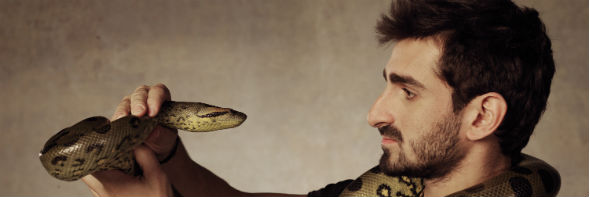
On
Dear @Discovery, is this 'Eaten Alive' special just a marketing hoax? How's the guy gonna get out? Are you starving a snake in preparation?
— Miles Klee (@MilesKlee) November 5, 2014
Discovery Channel is going to have a special about a man willingly eaten alive by an anaconda? Is this like that Mermaid documentary hoax?
— Goodnight, Nite (@goodnightnite) November 3, 2014
Really hope this #EatenAlive thing on @Discovery is some kind of elaborate hoax or they should be bloody ashamed of themselves #cruel
— Tom Woodward (@the_woodster) November 6, 2014
A petition against the special was also started online:
"The Discovery Channel is now committing animal abuse for creating a show called "Eaten Alive." A grown man in a "special suit" is planning on being eaten alive by a Green Anaconda. This is animal abuse to the highest degree and absolutely disgusting, and could kill the snake - an adult green anaconda cannot fit the width of an adult man's shoulders into it's body. It once again reinforces the negative stereotype of snakes, which one would think would be the opposite of what Discovery should be trying to do. Please sign this petition and boycott the Discovery Channel and get this show taken off the air. I would like everyone to tweet and post to the Human Society so a prominent organization can take action."
While this stunt may have seemed like a cruel hoax, the Discovery Channel, as well as naturalist and wildlife filmmaker Paul Rosolie, insisted that there was nothing fake or cruel about Eaten Alive In a blurb about the show, the Discovery Channel wrote that Rosolie wore a special "snake-proof" suit as he went head-first into the belly of the beast, and Rosalie addressed the concerns about animal cruelty by saying that he would never hurt an animal:
If u know me - I would never hurt a living thing. But you'll have to watch #EatenAlive to find out how it goes down! https://t.co/QvxZO2dS3V
— Paul Rosolie (@PaulRosolie) November 5, 2014
OK, so where does that leave us? The Discovery Channel planned on showing a man getting eaten alive by an anaconda, and Paul Rosolie said that he would "never hurt a living thing." That meant that Rosolie would have to both enter and exit the belly of the beast without hurting the snake. At least one wildlife expert, zoologist Frank Indiviglio, didn't believe that feat to be possible:
@kevloria Discovery has taken a real nosedive in recent years; more nonsense
— Frank Indiviglio (@findiviglio) November 5, 2014
When the special finally aired, Paul Rosolie "was forced to call off his controversial anaconda experiment halfway through," disappointing many viewers while relieving others:
Donning a black armored suit, slathered in pig's blood, Mr Rosolie then moved tentatively 'on all fours' toward the enormous beast as the cameras rolled and his wife, Gowri, watched. Seconds later, the female anaconda - one of the world's most fearsome creatures - pounced on its 5ft 9ins victim, latching on to his head, before constricting his arms and body. Mr Rosolie felt his arm 'start to break' under the snake's grip, he ordered his team of fellow naturalists, doctors and vets to save him with just the top of his head in the animal's jaws. And get this: that wasn't a snake that Rosolie and his team happened upon during filming. Rosolie admitted that the production actually relied upon a Peruvian green anaconda in captivity to complete the experiment. Within minutes of the show, named 'Eaten Alive', being broadcast, people across America were taking to social networking sites to express their disappointment at the highly-anticipated footage.
In footage aired on the Discovery Channel, 27-year-old Paul Rosolie and his 10-strong team tracked down the 20ft-long, 18st anaconda to the headwaters of the Amazon river.
We don't know if Indiviglio was right about this stunt's being "nonsense," but we do know that the Discovery Channel is no stranger to blurring the line between fact and fiction. This is the network, after all, that fooled millions of viewers with fake documentaries about mermaids and sasquatch:
Last updated: 7 December 2014
